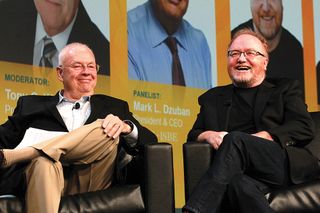Built for Streaming
As cable operators shift to broadband-first strategies, emphasizing high-speed internet access, industrywide tech organizations CableLabs and SCTE-ISBE are looking into the future to build next generation infrastructures.

A key part of that is upgrades to broadband networks, including 10G networks that will offer speeds of 10 gigabits per second. “10G is a major initiative for us and you will see the first trials in 2020,” Society of Cable Telecommunications Engineers-International Society of Broadband Experts president and CEO Mark Dzuban said.
Some of this is being driven by the move to higher-quality video formats, including High Dynamic Range (HDR) formats that offer much improved color and higher resolution formats like 4K and 8K. “We have a number of members that are working to prepare to start broadcasting in 8K around the 2020 Olympics,” explained Phil McKinney, the president and CEO of CableLabs.
RELATED:The New Normal: Streaming Takes Center Stage
The move towards streaming, internet-protocol video and a host of other services — ranging from gaming to video conferencing, education and telemedicine — are also driving demand for faster networks. “Low latency is a critical part of improving the gaming experience,” Dzuban said. “If you have multiple 4K terminals [TVs and other devices] streaming 4K or 8K video, that can exhaust bandwidth very quickly.”
Cord-cutting is another major factor. In a recent study of operators, OpenVault found that broadband usage hit 275 gigabits a month in the third quarter of 2019, up from 228 GB a year earlier.
Even larger increases were found in homes that cut the cord. OpenVault found that broadband customers who cut the cord in March of 2019 increased their usage from 387 GB a month to 488 GB by June of 2019. “Cord-cutting and consumers going on broadband only is going to have a major impact on their networks,” Mark Trudeau, CEO and founder of OpenVault, said.
Multichannel Newsletter
The smarter way to stay on top of the multichannel video marketplace. Sign up below.
Further down the pike are also new technologies like light field displays, noted Dzuban and McKinney. These light field displays show full, volumetric 3D images with no need for glasses.
McKinney noted that some smaller displays, about one foot wide, are already in operation and that CableLabs has been working on the technologies with members such as Charter for three and a half years. He said the first consumer applications should become available in the next three to eight years.
But those applications will require huge amounts of bandwidth and data, which makes the 10G initiatives even more important. “A five-minute clip will take up hundreds and hundreds of terabytes,” McKinney said. “To deliver that into a reasonably sized TV you need a gigabit network or maybe something a little faster.”
